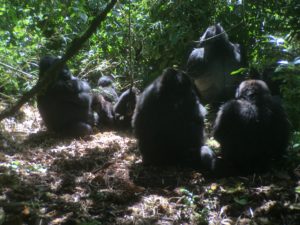
A troop of mountain gorillas in Rwanda’s Volcanoes National Park. Photo by Photo by Karen Shigeishi-Waite
In this guest post about unforgettable encounters with endangered mountain gorillas in the tiny African nation of Rwanda, contributing writer Robert Waite also provides an update on the status of the gorillas in the midst of the COVID-19 pandemic — and sees hope for optimism.
In his next post, Bob will detail the rest of his trip to Rwanda, a nation that endured a devastating genocide in the 1990’s and has now become one of Africa’s success stories.
By Robert Waite
Ruhengeri, Rwanda – As devastating as COVID-19 is to human populations, the consequences could be equally adverse for rhinos, elephants, gorillas and other sub-Saharan wildlife.
With flights suspended, borders closed and organized tours cancelled or indefinitely postponed, the region’s national parks and game reserves are struggling to protect animals that, at the best of times, are at risk.
Media reports out of South Africa and Kenya are already relating an uptick in poaching as tourist revenues dry up and local residents become more desperate.
My thoughts immediately turned to Africa’s mountain gorillas, found in the central African nations of Uganda, the Democratic Republic of the Congo, and Rwanda. These are the same gorillas brought to the world’s attention by the late Dian Fosse and featured in the film “Gorillas in the Mist”.
Word from the Warden
I had encountered these magnificent primates just over a year ago in Rwanda’s Volcanoes National Park. While there I had a chance to sit down with the Chief Park Warden, Proper Uwingeli.
After interviewing him over lunch at the lodge where my wife, Karen, and I were staying, I came away with the impression that the gorillas were in very good hands.
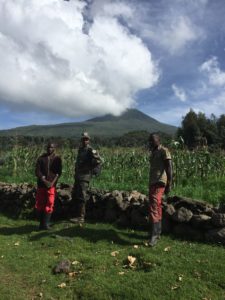
Trackers prepare for the hike into the forest to look for mountain gorillas. Photo by Karen Shigeishi-Waite
Due to poaching – there is a market in China for gorilla gall bladders and for their severed hands – and also due to general chaos during and after Rwanda’s horrifying 1994 genocidal civil unrest, the mountain gorilla population plummeted to near-extinction.
Today, thanks to the efforts of people like Warden Uwingeli, there are more than 1,000 gorillas, scattered across a highland habitat shared by three countries.
Alarmed that all of this progress was in danger of being undone during the pandemic, I contacted the warden.
“We too are concerned about losing all of the benefits associated with gorilla tourism,” he told me. “However, I can assure you that the gorillas continue to be well protected”. He added that trackers still visit and monitor the family units (often called troops) every day.
“As part of COVID-19 preventive measures, we require the trackers to wear masks and we have tripled the distancing to 30 meters (about 100 feet)”, he said.
For the moment, Rwanda’s borders are closed.
“I just want people to know we are keeping the gorillas safe,” Warden Uwingeli stressed. “They will be here for people to experience once it is safe to travel. We look forward to welcoming them.”
Deeply Moving Experience
Some people describe spending time with mountain gorillas as “life-changing”. While I tend to reserve that type of superlative for events like the meeting of a mate or the birth of a child, there is no question that it is a deeply moving experience, one that lingers long afterwards.
So you should take the Warden up on his offer to welcome you – when it is safe to travel.
As mentioned, there are three countries where you can trek to see mountain gorillas. After careful research, we decided Rwanda was easily the best choice.
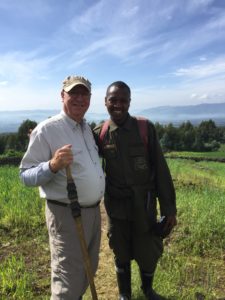
The author and guide before setting off on gorilla trek. Photo by Karen Shigeishi-Waite
Both Uganda and the Democratic Republic of the Congo have personal security issues, including civil unrest and disease outbreaks. The Congo, for example, was wrestling with Ebola.
Yes, the tours there and entrance fees are a fraction of those charged by Rwanda – U.S. $1,500 per person, per day – but in this instance you truly get what you pay for.
Up With the Sunrise
As is typical if you wish to see African wildlife, your day starts early – 6 a.m. in order to be at the park headquarters by 7. Once there, you will find things are organized with military precision.
A total of eight gorilla tracking permits per troop are available each day. You are organized into groups of eight, largely around trekking ability, and briefed by your guide on what to expect and how to act.
The dozen or so troops vary in size and are always on the move. But the trackers know where they bedded down the previous night – and have already gone on ahead at dawn to confirm the location.
We were assigned the largest troop, consisting of 31 gorillas. The troop is led, as they all are, by a dominant male silverback.
Our guide suggested we hire porters — not so much because we could not carry our own packs, but because it gives locals employment. Some, we were told, used to be poachers. At U.S. $10, it seemed a good investment.
First, Some Well-Considered Advice
Finding your troop can take as little as 45 minutes — and as much as four hours or more. Along the way, as you rise on the mountain’s shoulder through fairly thick brush, you are reminded of protocol.
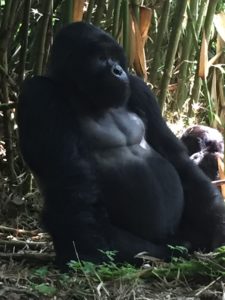
The silverback was engrossed in his huge bamboo-leaf salad. Photo by Karen Shigeishi-Waite
“If you are approached by a young male – a teenager – he will be testing you. Stand your ground,” our guide instructed. “If he gets closer, make this noise”. He then made a deep grunting sound that definitely would be noticed by any rational teenager — human or gorilla.
The advice was different, however, in the unlikely event that the silverback proved threatening or aggressive. “Submit. Crouch down. Turn your head and avoid eye contact,“ the guide told us, while drawing himself down into a near fetal position. At this point I noticed that one of the trackers had a rifle slung over his shoulder.
Spotting my glance, the guide whispered, “Just a precaution. We have never had to use it”.
Close Encounters of the Lyrical Kind
In less than an hour we were amidst the troop.
The silverback was huge – they weigh upwards of 350 to 400 pounds – and was preoccupied with eating bamboo leaves. Gorillas are herbivores and the silverback, in particular, must eat an enormous amount to maintain his weight and strength. Finding new vegetarian dining opportunities is another reason why the troop remains continually on the move.
Surrounding us was every aspect of domestic life, gorilla-style.
Mothers were nursing infants; young ones were playing, tumbling and jumping about; and, yes, here came the teenage males, testing boundaries.
One of them approached and challenged me. Puffing out my chest, I made an approximation of the grunting noise. The guide then chimed in with something much more fearsome, and the teenager backed away. These are skills one could have used on an elementary school playground.
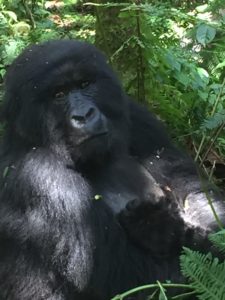
The 360-pound male silverback headed up the troop. Photo by Shigeishi-Waite
We stayed among the gorillas for just less than an hour, but it was a lyrical time. We came away in awe – and also wondering how it is that anyone would hunt these primates, who are so close to us as a species. You want to believe they can be kept safe, in part to demonstrate that humans can actually act humanely.
That is why I reached out to the Chief Park Warden – and why I was so relieved to learn they are being well cared for in these days of COVID-19. The promise he made is that they will be waiting for all of us when the all-clear is sounded – and that your visit is needed to further their conservation efforts.
If You Go
Advance park reservations are required, either through the Visit Rwanda website or with a reputable tour operator. We used Primate Safaris. Total number of trekkers is strictly limited to 96, so things fill up quickly.
We stayed at the Mountain Gorilla View Lodge, which offers comfortable bungalow accommodations on a spacious and secure property. A welcome drink and an evening performance by a local dance troupe add to the experience.
We traveled to Rwanda on Kenyan Airlines from Nairobi, landing at the Rwandan capital, Kigali. From there it is a bumpy three-hour drive to Ruhengeri.
As the gorilla habitat is found at a cooler 2,500 to 3,500 meters (8,000 to 12,000 feet) and the terrain can be quite rough, including stinging nettles, proper hiking attire is recommended, including gators over your footgear and gloves on your hands.
Next Up: Roaming Around Rwanda
Author Bio: Robert Waite has written on travel for almost 50 years. A former Pacific News Service correspondent, he is a professor at Seneca College in Toronto and Managing Partner at Waite + Co., a communications consulting firm with offices in Boston, Ottawa and Toronto.
Here are previous adventurous posts by Robert Waite that I recommend:










One Response to Gorillas in the Mist Are Not To Be Missed